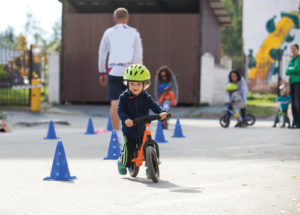
by Russell James
Glide Balance Bike Classes
Most children learn to crawl before they walk and to run before they bike. So it is therefore surprising that some people expect children to progress from tricycles and bicycles with stabilisers to bicycles, without having had the opportunity to master all aspects of static and dynamic balance.
Why is balance so important?
Physical inactivity in children can not only lead to health risks such as obesity, high blood pressure, diabetes and coronary artery disease, but can also lend to poor motor skills, having a detrimental effect on cognitive function and academic performance.(1)
Without effective transition from basic balance and sensory integration, learning and reading development can be significantly delayed.
Although balance maturation is not generally achieved in children until the age of 12, improving balance and sensory processing skills early in life will help children to excel – those with challenges like dyslexia, Down Syndrome, ADD and ADHD, improve dramatically.
What is balance?
Balance is the ability to maintain control of a particular body position whilst performing a given task with minimal postural sway. This could be achieved simply by sitting at a table, standing on one leg or riding a bike. Maintaining control of body positioning requires good static and dynamic balance reducing the energy required to perform a host of tasks and activities whilst minimising fatigue.
Static balance is the ability to maintain control of a position whilst remaining stationary – for example, balancing on one leg or holding a headstand.
Dynamic balance is the ability to maintain balance and control of the body whilst moving, such as hoping, jumping, riding a bike or snowboarding.
 Developing skills
Developing skills
Fundamental motor skills are the building blocks for engagement in physical activity and aid all aspects of the learning process. If these skills are underdeveloped in childhood, a child’s ability to participate in and enjoy physical activity can be greatly diminished. In practicing gross and fine motor skills, children not only gain intellectually, but also grow in strength, develop new skills and enjoy increased confidence levels in the face of new challenges.
Balance bikes promote symmetry, particularly with the upper body being encouraged to hold the handle bars steady whilst the lower part of the body is able to move freely and evenly. Balance, postural control and symmetry all help children develop the basic skills for any future physical activity.
Balance is vital to achieving success in almost every sport or physical activity and is fundamental in the process of learning to ride a bike. Through practice with balance equipment and balance bikes, children gain the ability and confidence needed to ride a pedal bike with confidence.
A recent study by the Child Growth Foundation concluded that 1 in 10 children never learnt to ride a bike.
Balance bike classes provide a safe introduction to address the need to get children at a young age exposed to cycling for fun, to encourage active lifestyles and to adopt alternative transport methods in the future.
Glide Balance bike classes are based on the Balanceability programme which has been specially designed by child development experts and cycling professionals. Classes are aimed at 2-4 year olds and last for 45 minutes. Led by a qualified instructor, children will learn the fundamental skills of cycling through play and adventure.
1. Medical Daily Oct 28 2014 Source: Balanceability course training and delivery manual.











